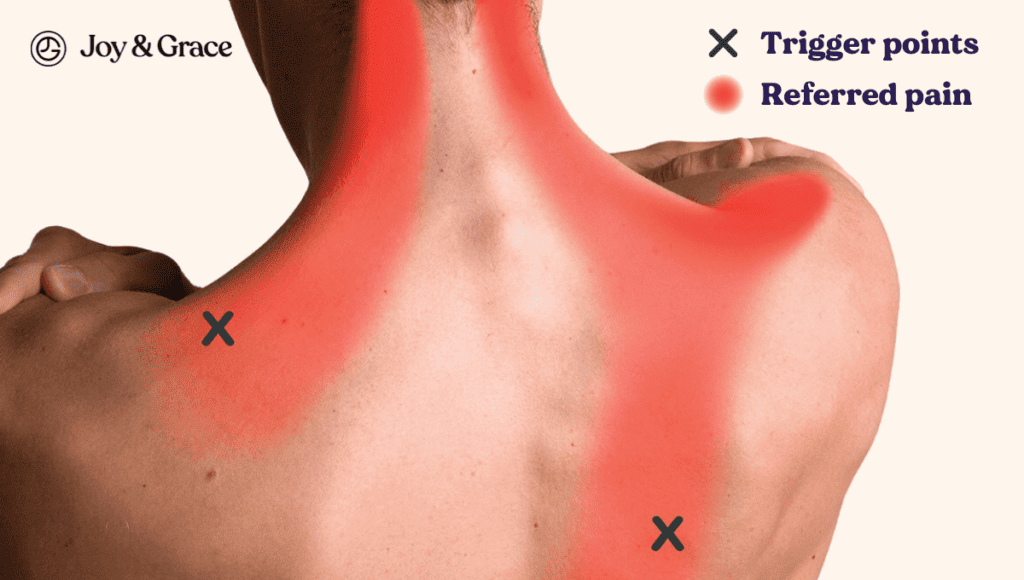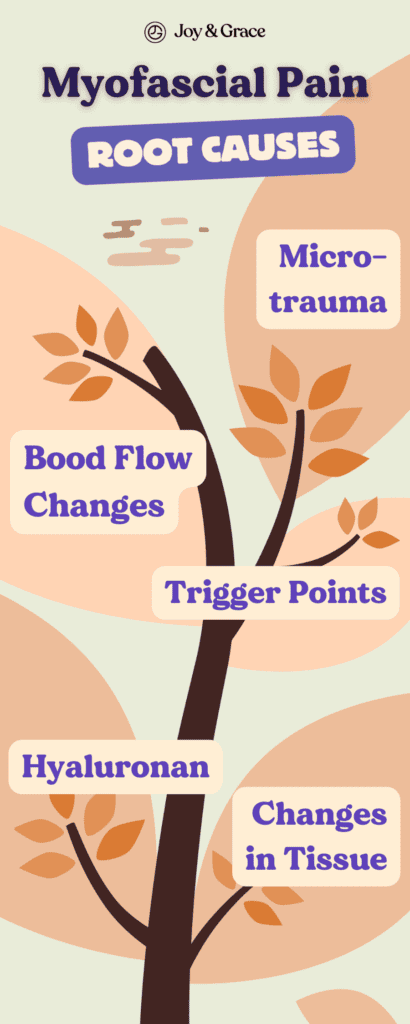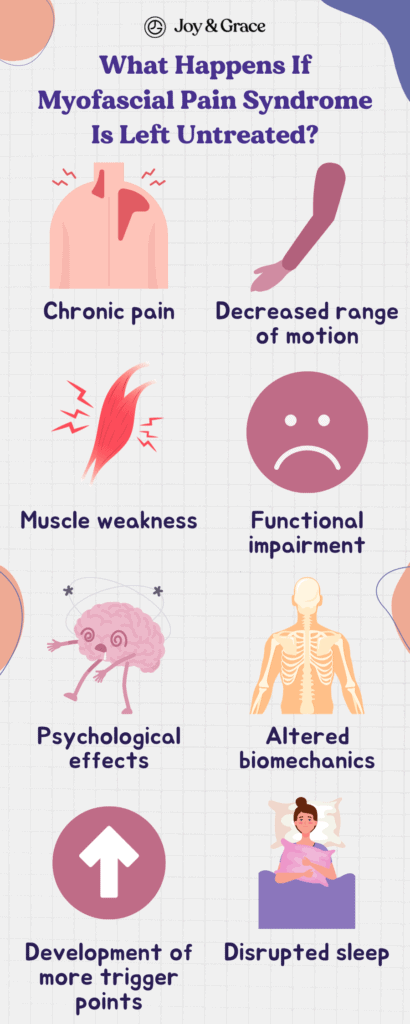Has a persistent, nagging pain in your neck and shoulders stolen your daily joy? You're not alone. Your discomfort may be due to an unfamiliar enemy called myofascial pain syndrome. Up to 93% of people with muscle pain can have myofascial pain syndrome.
But don't worry. We've got your back (and your neck and shoulders, too)! In this blog, we'll be delving into what myofascial pain syndrome is and, most importantly, how to deal with it.
What Is Myofascial Neck Pain Syndrome?
Myofascial Neck Pain Syndrome is a pain condition originating in the muscles and surrounding fascia.
Myofascial neck pain syndrome is characterized by tender and painful points (also called trigger points) in the muscles and fascia of the neck region. It’s part of myofascial pain syndrome (MPS), which can cause pain in various parts of your body. It is sometimes called cervical myofascial pain when it occurs in the neck.
Myofascia is the interplay between connective tissue, the fascia, and your muscles. The fascia acts like a “bodysuit” and wraps around your muscles. The fascia gives muscles their shape and helps them function. It also goes into the muscles and guides the nerves and blood vessels.
The ends of myofascia are thicker, forming the attachment sites of the muscles to the bones. This is important because it transfers muscle movement to the bones, allowing you to move your body.

Trigger points are tight knots or bands of muscle fibers that can be felt under the skin. They are often sensitive to touch and can cause pain both at the site of the trigger point and in the surrounding areas. For example, trigger points in the neck muscles can cause neck pain and tenderness that can also be felt in your shoulders.
According to a journal, around 20% of orthopedic clinic patients have myofascial pain. Furthermore, over 80% of patients who visit pain management centers suffer from myofascial pain.
We don't have a clear picture of how myofascial pain syndrome forms, but researchers have come up with different ideas to explain it.
What Is The Root Cause Of Myofascial Pain In The Neck And Shoulders?

As we mentioned, the cause of myofascial pain syndrome is unclear.
However, there are some theories on the possible causes of myofascial pain syndrome:
Microtrauma
If the muscles are constantly stressed or injured in small ways, they use up their energy quickly. This can lead to more pain signals being sent to the brain, especially in certain types of muscles.
Trigger Points
These are specific areas where muscles might continue to contract even when the brain doesn't tell them to. This can happen if there's too much of a chemical called acetylcholine. This can lead to pain and inflammation. There are four types of trigger points:
- Active Trigger Point
An active trigger point is a localized area of increased sensitivity in a muscle. It’s characterized by taut bands of muscle fibers that cause pain when stimulated. This pain may be felt directly at the trigger point site or radiate to other body areas.
- Latent Trigger Point
A latent trigger point is located within the muscle but remains dormant or inactive. It doesn't cause pain. You might not even know you have it. However, certain factors can activate it.
- Secondary Trigger Point
A secondary trigger point is a trigger point in a muscle other than the one with the primary active trigger point. A primary active trigger point and a secondary trigger point can be active simultaneously.
- Satellite Trigger Point
A satellite trigger point is a trigger point that develops near another active trigger point. Because it overlaps with another trigger point, it becomes inactive.
Changes in Tissue
When the tissue around muscles changes, the nerve endings in this tissue can become more sensitive to touch or pressure. The most common change causing pain is stiffness or tightness. This can also lead to muscles contracting on their own.
Hyaluronan
Hyaluronan is a substance our body produces that helps muscles and tissues slide against each other. If this substance changes, it can make things stick together, making it harder for muscles to move. Over time, this may lead to pain.
Blood Flow Changes
If the blood flow in the muscles changes, it can lead to less oxygen getting to the muscles. This lack of oxygen can activate pain-sensing nerves.
What Triggers Myofascial Pain In The Neck And Shoulder?

Numerous factors can cause myofascial pain in the neck and shoulder, including:
- Muscle Overuse or Strain
The primary triggers of Myofascial Pain Syndrome are muscle injury and overuse.
Repetitive activities can lead to muscle overuse or strain in the neck and shoulder areas, causing myofascial pain.
- Postural Issues
Poor posture, whether while sitting, standing, or working, can strain muscles and fascia in the neck and shoulder region over time.
- Muscle Imbalances
Muscle imbalances can result in excessive stress in specific areas, leading to myofascial pain. Muscle imbalance occurs when certain muscles are stronger or tighter than others.
- Trauma or Injury
Accidents, falls, or other traumatic events can cause muscle damage or trigger points in the neck and shoulder regions.
- Stress and Tension
Emotional stress and anxiety can contribute to muscle tension, which may lead to myofascial pain.
- Lack of Physical Activity
A sedentary lifestyle and lack of regular exercise can weaken muscles and lead to myofascial pain.
Can Stress Cause Myofascial Pain In My Neck And Shoulders?

Stress can indeed trigger myofascial pain in your neck and shoulders.
According to a study, psychological factors can contribute to the development of trigger points and chronic pain. In another study, myofascial trigger points were associated with depression, anxiety, and stress.
The relationship between stress and myofascial pain may be due to chemicals produced by your body called neurotransmitters. One example of a neurotransmitter is acetylcholine.
Acetylcholine acts like a messenger in your body, helping your nerves communicate with your muscles. It tells your muscles when to move and aids the brain in controlling your body's actions.
As we mentioned earlier, acetylcholine is associated with the development of trigger points. And according to an experimental study done in mice, acute and chronic stress can cause an increase in the release of acetylcholine. You get the point.
Furthermore, according to the same study, chronic stress may cause the development or persistence of myofascial pain.
What Vitamin Deficiency Causes Myofascial Pain?
Nutritional deficiencies can also be a risk factor for myofascial pain. According to a study, deficiencies in the following vitamins can activate trigger points:
- Vitamin B1
- Vitamin B6
- Vitamin B12
- Folic Acid or Vitamin B9
Vitamin D and iron deficiency are also involved. In one study, people with myofascial pain syndrome were found to have lower zinc levels.
What Are The Symptoms Of Myofascial Pain Syndrome In The Neck And Shoulders?
If you're wondering whether you may be grappling with myofascial pain syndrome, certain telltale signs can point you in the right direction. The main symptoms of myofascial pain are:
- Localized Pain
The pain may be persistent or intermittent, often felt in specific areas of your neck and shoulders. The pain can feel like a deep ache or a throbbing or squeezing sensation.
- Trigger Points
A hallmark of myofascial pain is the occurrence of trigger points. Trigger points are specific points within muscles that are sensitive and can cause referred pain. Pressing on these points can reproduce or intensify the pain. Sometimes, you may feel them as bumps on your neck and shoulders.
- Referred Pain
Pain from trigger points can radiate to other areas, causing pain and discomfort in regions other than the actual source of pain.
- Limited Range of Motion
Myofascial pain can lead to stiffness in the neck and shoulders. This can make it challenging to move your head and arms freely. Attempting to move beyond this 'comfort zone' can cause additional pain or discomfort.
The pain from myofascial pain syndrome can also come with:
- Headaches
Trigger points in the neck and upper shoulders can contribute to tension headaches and, less commonly, migraines.
- Muscle Weakness
In some cases, muscles affected by MPS may weaken, leading to difficulties with daily activities and muscle function. But usually, no atrophy (decrease in muscle size) can be noticed.
- Sleep Disturbances
Pain and discomfort may make finding a comfortable position difficult, leading to disrupted sleep.
- Fatigue
Constant muscle tension and pain can contribute to overall fatigue. This can decrease your ability to engage in physical activities.
- Stress and Anxiety
Chronic pain can increase stress and anxiety, creating a feedback loop that exacerbates muscle tension and pain.
Can Myofascial Pain Cause Nerve Pain?
Indeed, it can. How so, you ask? As we mentioned earlier, myofascial pain results from tightened knots of muscle fibers known as “trigger points.” These trigger points can also be muscle adhesions.
Muscle adhesions are, essentially, layers of muscle getting stuck together. These adhesions can press on surrounding nerves, triggering nerve pain.
Tight muscles and adhesions can compress a group of nerves in your upper body called the brachial plexus. This can present similarly to a pinched nerve, causing the pain to travel from your neck down to your arm.
How Is Myofascial Pain Syndrome Diagnosed?
The diagnosis of myofascial pain syndrome usually includes:
Medical History
Initially, your doctor will take a thorough medical history. They will ask you questions regarding the pain, including:
- Onset
- Location
- Intensity
- Duration
- Nature or characteristic
- Whether the pain spreads
- Activities that worsen or relieve the pain
They will also ask you questions about the following:
- Potential triggers
- Recent injuries or trauma
- Any existing underlying conditions
- Past injuries, surgeries, or illnesses
Physical Examination
Then comes the physical examination. Your doctor will perform a thorough physical examination to assess the muscles and fascia of the affected area.
Your healthcare provider would typically look for specific, tender trigger points in your neck and shoulder area. They might use manual pressure or a tool to locate these points. Then they will stimulate these points to cause pain.
They will also examine your shoulder and neck’s range of motion, as well as your posture and muscle strength.
Imaging and Tests
These include imaging studies like an MRI. These tests can help check for structural abnormalities or visualize muscle and tissue health. But note that MPS doesn't usually show up on these techniques but could help rule out other conditions.
Other tests used to diagnose myofascial pain syndrome include:
- Ultrasound Imaging
Uses sound waves to examine trigger points and how different parts of the tissue move. A special ultrasound can show if these trigger points are stiff and have decreased blood flow. Problem areas look like spots that reflect less sound.
- Micro-Dialysis
Checks for inflammation at muscle trigger points. It also detects substances that might cause pain.
- Electromyography (EMG)
This looks at the electricity at active and latent trigger points. Problem areas show more electricity when muscles move.
- Infrared Thermography
Measures how warm your skin is over trigger points
That said, there are a variety of conditions that can cause neck and shoulder pain. While no single test confirms MPS, the combination of history, physical examination, and imaging can lead to a proper diagnosis. Fortunately, several treatment strategies can help you manage the pain once it’s identified.
How Do I Relieve Myofascial Pain In The Neck And Shoulders?

Here are some simple ways to help relieve myofascial pain in your neck and shoulders.
Stretching and Mobility Exercises
Gentle stretching and mobility exercises can help relieve tension. They also help you regain your range of motion. Focus on movements that target the neck and shoulder muscles. Slow and controlled stretching is key to avoiding further strain. We will list some exercises later in this article.
Foam Rolling
Using a foam roller can also help release tension in the myofascial tissues. Gently roll the foam roller over the affected areas, applying moderate pressure. Make sure to avoid rolling directly on the spine or joints. If you can’t find a foam roller, you can use a tennis ball as an alternative!
Make sure to continue reading, as we’ll talk more about foam rolling later.
Massage
Consider getting a professional massage from a licensed therapist specializing in myofascial release techniques. This can help to loosen tight muscles and promote relaxation.
Self-applied myofascial release techniques can also provide comfort at home. But don’t overdo it. Overzealous or improper techniques can contribute to discomfort rather than relieve it.
We’ll talk more about the benefits of massage and myofascial release for myofascial pain later.
Heat and Cold therapy
Applying heat to the affected areas can help relax muscles and improve blood circulation. You can use a heating pad or warm bath to ease the discomfort. Meanwhile, cold packs or ice wrapped in a cloth can help reduce inflammation and numb the area. This may provide temporary relief from pain.
Improve your posture
Poor posture can contribute to myofascial pain. Be mindful of your posture while sitting, standing, and using electronic devices. Maintaining good posture can prevent unnecessary strain on your neck and shoulders. This is an underrated but extremely effective way of managing myofascial pain in the neck and shoulders.
Proper ergonomics
If you spend much time working at a desk or using a computer, ensure your workspace is ergonomically designed. An ergonomic workspace can minimize strain on your neck and shoulders.
Stress Management
As we mentioned earlier, stress can worsen or cause myofascial pain. Engage in relaxation techniques such as deep breathing, meditation, or yoga to help manage stress levels. We have separate articles about Yoga for neck pain and Yoga for shoulder pain.
Over-the-Counter Pain Relief

Non-prescription pain relievers can help alleviate pain and reduce inflammation. These include drugs like ibuprofen and acetaminophen. However, these should be used cautiously and as directed by a healthcare professional.
Hydration and Nutrition
Proper hydration and a balanced diet can contribute to muscle health. Consuming nutrient-rich foods may help support your body's ability to recover. Make sure to eat foods that contain:
- Vitamin D
- Iron
- Vitamin B complex
- Zinc
Simultaneously, hydration is essential. Dehydration can lead to muscle tightness or spasms, worsening myofascial pain. So, make sure to drink plenty of water throughout the day.
Physical Therapy
A physical therapist can design a personalized exercise and stretching program to target your pain areas. They can also teach you techniques for self-management.
Is Massage Good For Myofascial Pain?
Indeed, massage can be beneficial if you suffer from myofascial pain in the neck and shoulders. In one study, patients who received deep tissue massage had lesser pain and a better range of motion in the neck. Some of these benefits can possibly extend to different types of massage, too.
In another study, patients who received traditional Thai massage had less pain in the trigger points in their trapezius muscles. The trapezius is a muscle that extends to the back of your neck and shoulders. However, this massage did not improve the patient’s range of motion.
So if you’re still on the fence about getting a massage, this is your sign to book an appointment!
We have separate articles about the benefits of massage for both neck and shoulder pain.
Is Heat Good For Myofascial Pain?

As mentioned earlier, applying heat can help relieve myofascial pain around your neck and shoulders. Heat therapy, whether via hot packs, warm baths, or heat wraps, can bring about soothing relief by improving blood flow.
In one study, heat packs with ultrasound therapy increased blood flow to the affected site and increased the area’s tolerance to pain.
This is important because, as we mentioned earlier, decreased blood flow to the muscle can activate the nerves that sense pain.
What Is The Best Sleeping Position For Myofascial Pain In The Neck And Shoulder?
No studies have yet identified the best sleeping position for myofascial neck and shoulder pain.
However, there are studies on the best sleeping positions that help prevent or relieve neck and shoulder pain in general. And these sleeping positions might also help with your myofascial pain. Modifying your sleeping position is one of the simplest changes you can make. This can make an enormous difference in your discomfort's intensity and frequency.
Sleeping on your stomach can worsen neck and shoulder pain, creating unnecessary strain.
Switching to sleeping on your back or side is recommended to ease this strain. In these positions, your neck and shoulders are well-supported, which can help relieve pain.
Can I Exercise With Myofascial Pain?
Absolutely! Certain exercises can be beneficial in managing myofascial pain in the neck and shoulders.
Gentle and regular stretching exercises can help break down fascial adhesions. They can also improve your mobility and reduce pain. However, you should make sure to move slowly, as rushing doesn’t help. And remember to breathe deeply, as it can help you relax.
One study tested a combination of treatment methods in patients with chronic myofascial shoulder pain. The patients received the following treatments once a week:
- Manual compression of trigger points
- Stretching
- Cold therapy
The patients were also asked to perform stretching and relaxation exercises at home and maintain good posture.
After 12 weeks, the patients who received treatment had less pain and improved disability scores.
55% of the patients reported that their condition had slightly improved or completely recovered.
According to another review, exercise can cause a more significant reduction in myofascial pain when combined with stretching and strengthening exercises.
Finally, there is a 2018 study that the University of Toronto conducted. In it, patients were asked to do any aerobic exercise for four weeks.
After four weeks, patients had less myofascial pain in the lower neck and shoulder. The patients also had fewer trigger points. Furthermore, patients who performed water base aerobics such as swimming had a greater pain tolerance in the neck region.
What Is The Best Exercise For Myofascial Pain In The Neck And Shoulders?
As mentioned earlier, exercise works best when combined with stretching and strengthening exercises. Below, we’ve listed some exercises that combine these two. These exercises use gentle movements and stretches to help relieve muscle tension and break up adhesions.
- Neck stretches
- Sit upright in a chair.
- Tilt your head to one side, trying to align your ear with the shoulder on the same side.
- Hold this position for 20-30 seconds.
- Repeat the process on the other side.
- Shoulder rolls
- Stand or sit straight and roll your shoulders in a circular motion.
- Perform forward rolls and then switch to backward rolls.
- Wall push-ups
- Stand about an arm's length away from a wall.
- Place your palms flat against the wall at chest height.
- Bend your elbows to bring your chest closer to the wall.
- Push yourself back to the starting position.
We have more exercises here.
When done consistently, these exercises can help manage myofascial pain in the neck and shoulders. While you can do these exercises safely at home, it’s best to seek the guidance of a fitness professional or a physiotherapist.
Can I Lift Weights With Myofascial Pain Syndrome In The Neck And Shoulders?
You may be wondering if lifting weights could help deal with myofascial pain. Unfortunately, the answer is more complex than a simple yes or no. It largely depends on your condition and, of course, how you approach weightlifting.
Weightlifting can be beneficial for your overall health. However, it's essential to exercise with intention and caution. Weightlifting with neck and shoulder pain can be a recipe for disaster.
Aggressively lifting heavy weights without proper form can also worsen your myofascial pain. Furthermore, weightlifting can cause more microtrauma and tears.
Although strengthening exercises could help decrease myofascial pain, gradual progress is essential. Start with lighter weights and gradually increase them as your strength and condition improve.
Remember, fatigue can do more harm than good while dealing with myofascial pain syndrome. Listen to your body and stop if any exercise worsens your condition.
What Vitamins Are Good For Myofascial Pain Syndrome?
There’s no specific vitamin or mineral that can help relieve myofascial pain. And there’s no need to take a supplement containing a single vitamin unless you’re severely deficient. Your daily multivitamin and diet are enough as long as they contain sufficient amounts of:
- Vitamin D
- Vitamin B complex
- Iron
- Zinc
- Other vitamins and minerals, such as magnesium and vitamin C
However, your doctor may recommend a specific supplement if you are severely deficient in one vitamin or mineral.
Remember, while vitamins can be part of your strategy against myofascial pain, exercise and diet play an integral role too. Healthy eating habits and exercise can help you manage the pain better.
What Is The Best Diet For Myofascial Pain?
There’s no “best diet” for myofascial pain. However, a diet that aims to reduce inflammation is typically recommended for myofascial pain. This generally involves increasing your intake of:
- Fruits
- Vegetables
- Lean proteins
- Whole grains
You may also have to limit the consumption of:
- Processed foods
- Sugars
- Unhealthy fats.
A perfect example is the Mediterranean diet. This diet is high in omega-3 fatty acids, known for their anti-inflammatory properties. Don’t worry. We’ll be listing down some foods high in omega-3 fatty acids. We’ll also list the foods and drinks you should avoid.
What Are The Best Foods For Myofascial Pain Syndrome?
Here are some foods you can add to your diet to help relieve your pain:
Anti-Inflammatory Foods

Some cases of myofascial pain syndrome may be associated with inflammation. Consuming foods rich in anti-inflammatory compounds can help reduce inflammation and alleviate pain. Some examples include:
- Fatty fish high in omega-3 fatty acids
- Salmon
- Mackerel
- Sardines
- Fruits and berries rich in antioxidants
- Blueberries
- Strawberries
- Cherries
- Citrus fruits
- Avocado
- Leafy greens which provide vitamins and minerals
- Spinach
- Kale
- Collard greens
- Lettuce
- Cabbage
- Nuts and seeds
- Almonds
- Pumpkin seeds
- Sunflower seeds
- Chia seeds
- Flax seeds
- Walnuts
- Whole grains
- Brown rice
- Quinoa
- Whole wheat
Foods rich in vitamin D

Vitamin D deficiency is a contributing factor in myofascial pain syndrome. So aside from enjoying the sunlight, consider adding these foods to your diet:
- Eggs
- Cheese
- Cow’s milk
- Plant-based milk fortified with vitamin D
- Fish
- Cereals
Lean proteins
Consuming adequate protein is crucial for muscle health. However, make sure to consume lean animal meats or plant-based proteins, such as:
- Poultry
- Tofu
- Beans
What Foods Should I Avoid With Myofascial Pain Syndrome?
Certain foods can exacerbate symptoms of myofascial pain syndrome in your neck and shoulders. You may notice your pain can worsen when eating inflammation-inducing foods. Let's delve into what some of these food culprits might be:
Processed foods
Processed items are high in unhealthy fats and sugars that can spur inflammation. These include:
- Processed meats
- Pre-packaged meals
- Canned food
Sugary Drinks
Beverages high in sugar, such as sodas and certain fruit juices, stimulate inflammation and might intensify your pain.
Alcohol
Overindulging in alcohol can cause dehydration. Dehydration can lead to muscle tension and possibly worsen myofascial neck pain.
Caffeine
Too much caffeine can trigger muscle spasms. This can potentially worsen myofascial pain in your neck and shoulders.
Gluten
For some, gluten can trigger an inflammatory response. If you've noticed a link between gluten consumption and worsening, it might be worth discussing with a dietician.
It may seem like you’re missing out on some of life’s greatest pleasures, but remember, you don’t have to remove these delicacies from your life altogether. You can still enjoy them as long as you listen to your body.
Remember, our bodies are unique. You might consider keeping a food diary to track what you eat and how it impacts your symptoms. This could help you identify foods that trigger or relieve your myofascial neck and shoulder pain.
How Do I Prevent Myofascial Pain in the Neck and Shoulders?
There are three areas of focus for preventing myofascial neck and shoulder pain. These are the same things you can do to help relieve your pain, including:
- Reducing muscle tension
- Practicing correct posture
- Overall lifestyle changes
So as long as you are consistent with the self-care methods we mentioned, you can prevent myofascial pain from happening or returning.
How Do Healthcare Providers Treat Myofascial Pain In The Neck And Shoulders?
If your myofascial pain is from an underlying condition, your doctor will address those issues first. If your pain persists, your doctor will proceed with treatment targeting myofascial pain.
Pharmacologic Treatment

This involves the use of medication. While these drugs offer significant relief from myofascial pain, they can have harmful side effects. Make sure to talk with your healthcare provider thoroughly about these effects. And strictly follow your doctor’s instructions regarding frequency and dosage.
Analgesics
These drugs are commonly known as pain relievers or painkillers. Your healthcare provider may suggest the use of OTC painkillers. However, they may prescribe you stronger ones depending on the severity of your pain.
Examples of painkillers commonly used to treat myofascial pain include:
- NSAIDS
- COX-2 inhibitors
- Tramadol
- Lidocaine patches
- Tropisetron
Muscle Relaxants
These drugs help relax your muscles by acting on your nervous system and stopping the overactivity of your muscles. These can include:
- Tizanidine
- Benzodiazepines, such as clonazepam
- Cyclobenzaprine
- Thiocolchicoside
Anticonvulsants
These drugs help by preventing the release of chemicals involved in pain sensation. These include:
- Gabapentin
- Pregabalin
Antidepressants
These drugs can regulate neurotransmitters in the brain that affect pain processing. They also help regulate your mood. These drugs include:
- Tricyclic antidepressants, such as amitriptyline
- Duloxetine
- Sumatriptan
Botulinum Toxin A
This is commonly known as botox. This drug prevents muscle contraction and can inhibit the release of chemicals involved in pain processing. According to a study, botox reduced the duration and intensity of pain and the number of trigger points.
Non-Pharmacologic Treatment
Non-pharmacologic treatments for myofascial pain syndrome are methods that don’t use medications. These treatments include the lifestyle changes we mentioned earlier and various medical approaches.
Injections into trigger points
Needles are used to disrupt muscle trigger points. This can stop muscle overactivity and pain. They can also help increase blood flow. These include:
- Dry needling
It is a fast and effective method to inactivate trigger points. It’s called “dry needling” because no medications are used.
According to a study, dry needling is more effective when combined with heat therapy.
- Trigger point injections
Similar to dry needling but with injected anesthetic solutions. It’s as effective as dry needling with less discomfort.
Manual Therapy
This includes:
- Deep tissue massage
- Stretching
- Heat
- Myofascial release
Ultrasound
Uses sound waves to improve the muscles' blood circulation and energy metabolism.
Transcutaneous Electric Nerve Stimulation (TENS)
Uses electrical currents to relieve pain.
What Is Myofascial Release?
Myofascial release is a therapeutic technique that aims to release tension and adhesions within the fascia to relieve pain and restore proper muscle function. This technique is also called trigger point therapy.
However, according to a review, there isn’t enough evidence to support the use of this method for chronic muscle pain.
Furthermore, there aren’t any proper guidelines on how much pressure to apply. This may lead to poor results if done too softly or complications if extreme pressure is applied.
Before you take this treatment route, always get proper medical advice from a healthcare professional.
Myofascial release can be performed using various techniques, including:
Manual Manipulation

A trained therapist uses their hands to apply gentle, sustained pressure to the restricted areas of the body. The pressure is maintained for a period of time to allow the fascia to release and relax.
This is different from your regular massage. Your therapist won’t be using any oils or lotions so that they can get a better feel for any trigger points and tightness. Then they will slowly stretch and apply gentle pressure to the affected areas until the tightness is released.
Foam Rolling

Foam rolling involves using a foam roller to apply pressure and self-massage specific muscle groups. By rolling over the foam roller, you can target areas of tension and help release fascial restrictions. According to a study, rolling for 90 seconds may be enough to reduce pain.
In another study, self-myofascial release with a foam roll for 90 seconds was found to decrease pain sensitivity at latent trigger points.
However, there’s a catch.
This effect was only seen in the group that used static pressure. This means they only applied pressure without any rolling.
Furthermore, a review challenges the reported benefits of foam rolling due to a lack of supporting evidence.
You should also avoid foam rolling if you have any of the following conditions:
- Open wounds
- Burns
- Deep vein thrombosis
- Osteomyelitis
- Use of blood thinners
Again, consult a healthcare professional before trying foam rolling.
Specialized Tools
Some therapists use other specialized tools designed to apply pressure to trigger points. These tools can help break up adhesions and release tight fascia.
How Can I Do Myofascial Release To Relieve Shoulder And Neck Pain?
If you really want to try myofascial release for yourself, here's how you can perform myofascial release to relieve shoulder and neck pain at home:
- Gather materials and set the mood
- A foam roller or myofascial release ball (lacrosse ball, tennis ball, or specialized massage ball)
- A Comfortable and quiet space
- Warm Up
Before you start, perform a light warm-up to increase blood flow to the target areas. Gentle movements like shoulder circles and neck stretches can help prepare your muscles.
- Find Trigger Points
Identify the areas of your shoulder and neck that are particularly tense or painful. These are usually areas with knots, tender spots, or tightness.
Foam Roller Techniques
Neck
- Neck Warm-Up
- Use a foam roller against a door or wall.
- Ensure the foam roller supports the curve of your neck, starting at the base of the skull.
- Lean slightly away from the door or wall, pressing into it with your legs for support.
- Perform a chin tuck and roll your neck slowly over the foam roller, applying gentle pressure with your legs.
- Repeat this motion for 10 to 15 repetitions.
- Side-Specific Stretch
- Turn your head toward one side (e.g., left).
- Roll your neck slowly, focusing on the side you turned your head to.
- Repeat for the opposite side as well.
- Self-Release Method - Rotation
- Maintain an upright posture and perform a chin tuck.
- Turn your head as much as possible in one direction, creating a deep stretch.
- Hold the stretch for about 10 seconds.
- Increase the stretch by pressing gently into it with your hand.
- Repeat this stretch on both sides for 3 to 5 repetitions.
- Self-Release Method - Armpit Sniffer
- Rotate your head again, looking over your shoulder.
- Place your hand on the top of your head and gently pull your head down toward your armpit.
- Hold the stretch for 10 to 15 seconds and repeat 3 to 5 times on both sides.
- Upper Trapezius Release
- Bend the arm on the side you want to target.
- Slide your hand across your lower back.
- Turn your head toward the opposite side.
- Using your free hand, gently tilt your head towards your shoulder to create a deep, comfortable stretch.
- Hold for 10 to 15 seconds and repeat 3 to 5 times on both sides.
Shoulder
- Shoulder Pop and Roll
- Kneel on the floor with a foam roller in front of you.
- Grip the foam roller and press down into the floor for stability.
- Tuck your chin and lower your body backward, feeling a stretch in the arms and shoulders.
- Move your hands to the sides of the foam roller and roll your upper body forward to deepen the stretch.
- Hold the deep stretch for 15 to 20 seconds and repeat for 3 to 5 sets.
- Angled Shoulder Pop and Roll
- Angle the foam roller to one side and lean slightly in the opposite direction.
- Roll your upper body forward, feeling a deeper stretch on the opposite side.
- Repeat on the other side to balance the stretch.
- Chicken Wing Popper
- Position the foam roller vertically next to a wall.
- Bend your elbow and support your arm on the foam roller, pressing into it for stability.
- Place your free hand on your hip.
- Maintain a straight line from shoulder to elbow and look to the side.
- Press your elbow into the foam roller for a deep stretch.
- Hold for 15 to 20 seconds, and repeat for 3 to 5 sets.
- For an additional stretch, gently perform a "chicken wing" motion by slightly winging your elbow.
Can I Use A Massage Ball Or Tennis Ball For Myofascial Release?
Yes, you can! Here’s how to use a tennis or massage ball to relieve myofascial pain in your shoulders:
- Stand against a wall or lie on the ground
- Place the tennis ball between your shoulder blades and the spine
- Use the wall or floor to apply pressure on the tennis ball and the affected area
- You can also roll the ball in between the wall and your body
- Focus on the area of tension and pain
Deep Breathing Technique
- As the tennis ball applies pressure, practice deep breathing to enhance the effectiveness of the exercise.
- Inhale deeply for a count of five.
- Exhale deeply for a count of five
You can also use a tennis ball to help relieve neck pain!
How Long Does It Take To Recover From Myofascial Pain Syndrome?
Myofascial pain syndrome can be divided into acute and chronic MPS.
Acute MPS causes pain in only 1 or 2 areas, usually from trauma and overuse. Acute MPS may subside within one week.
However, some people may develop chronic MPS. Chronic MPS causes more widespread pain and can last 6 to 180 months.
What Happens If Myofascial Pain Syndrome Is Left Untreated?

If myofascial pain syndrome (MPS) is left untreated, it can negatively impact your quality of life. Some potential consequences of untreated MPS include:
- Chronic pain
The most immediate consequence of untreated MPS is persistent and potentially worsening pain.
- Decreased range of motion
Over time, muscle tightness and discomfort can lead to a decreased range of motion in the affected muscles and joints. This can impact your ability to perform normal activities and lead to muscle imbalances.
- Muscle weakness
The pain and tightness caused by trigger points might lead to muscle weakness due to reduced use and limited movement.
- Functional impairment
MPS can interfere with your daily life. This can affect your work and stop you from doing what you enjoy. This can decrease your productivity and overall well-being.
- Psychological effects
Chronic pain can take a toll on mental health, leading to symptoms of anxiety, depression, frustration, and stress.
- Altered biomechanics
Untreated MPS can cause changes in posture and movement patterns as the body tries to compensate for pain and stiffness. These altered biomechanics can lead to additional musculoskeletal issues over time.
- Development of more trigger points
More trigger points can form in the surrounding muscles. This increases your overall discomfort.
- Disrupted sleep
Pain and discomfort can interfere with sleep quality, leading to insomnia or disrupted sleep patterns. Poor sleep can worsen pain and negatively affect overall well-being.
Is Myofascial Pain Syndrome Serious?
Myofascial pain syndrome may be a painful and sometimes debilitating condition. Still, it’s generally not considered life-threatening or directly severe in the same way that some other medical conditions can be. However, MPS can significantly impact your quality of life and overall well-being.
The severity of MPS symptoms can vary widely from person to person. While it might not be life-threatening, it should not be underestimated.
Takeaway
Myofascial pain syndrome in the neck and shoulders is characterized by muscle and fascial trigger points. It can cause chronic pain and limited range of motion.
A wide range of factors can trigger or worsen the condition. The exact cause of the condition remains unclear. However, a combination of treatments, including lifestyle changes, can help manage symptoms.
Though not life-threatening, the condition can significantly affect your quality of life.















